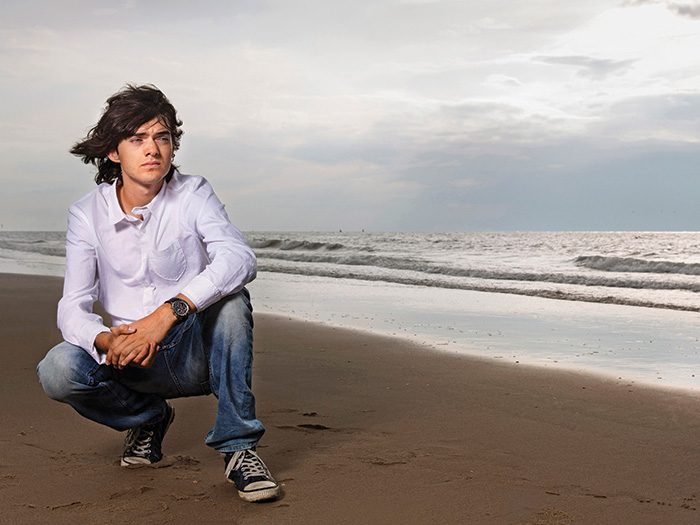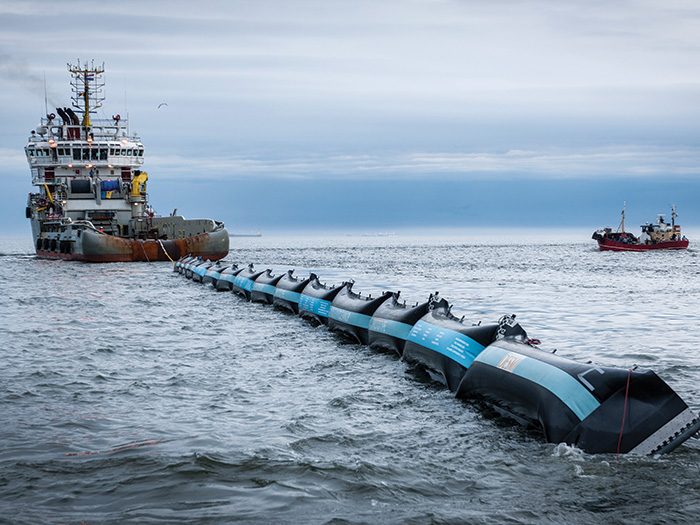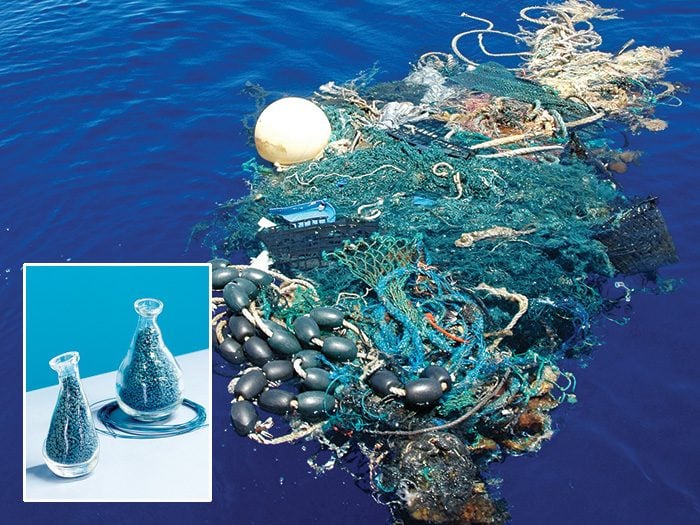European of the Year: Boyan Slat Wants to Clean Up the Oceans
Plastic pollutes the world’s oceans, killing marine life and damaging the planet. Boyan Slat just might have the answer

Our European of the Year is so young he still lives at home with his mother. Boyan Slat is 22. If you saw him walking down the street in Delft, Holland—a skinny guy who hasn’t shaved for a couple of days, with a long mop of dark hair, wearing jeans, his shirt hanging loose—you might think he was a student at the local Technical University. And so he was, four years ago, just before his life changed for ever.
Then again, if you saw him in a recent Huffington Post video, at the helm of an ocean-going yacht, wind blowing through his hair, you might take him for a singer in a boy band.
In fact, he is the founder of a non-profit group whose name exactly describes its purpose: Ocean Cleanup. His promise is as simple to understand as it will be difficult to achieve: “We can actually make the ocean clean again,” he says.
Ocean Cleanup’s aim is to use technological innovation to clear up the plastic currently floating in the so-called Great Pacific Garbage Patch, and the other places in the world’s oceans where ‘gyres’, or slowly rotating currents, trap huge amounts of plastic waste.
This 22-year-old is an environmentalist who sees technology as an ally, not the enemy. “I believe technology is the most powerful agent of change we have. It creates entirely new building blocks and opens up a massive amount of possibilities.”
Slat’s optimism and sense of possibility is immediately obvious. “People overestimate the consequences of failure,” Slat says, commenting on what he sees as “a bias in the world towards low-risk, low-impact projects.
“In the Fifties, Sixties and Seventies there was a wave of huge, crazy projects, such as the Apollo space program. In order to survive the next century we need to have that same crazy spirit.”
The challenge is huge. It’s estimated that between five and 14 million tons of plastic enter the oceans from land every year. The Ocean Conservancy charity has warned that in the next decade the world’s oceans could hold one kilo of plastic for every three kilos of fish. Plastic acts like a sponge, absorbing toxins in the water. When consumed by marine and wildlife, it can cause them to become sick and die, or, broken into tiny pieces, it may end up in the stomachs of fish—some of which humans may eventually eat.
Some 267 different species are known to have suffered from entanglement or ingestion of marine debris, including seabirds, turtles, seals and whales.
Ocean Cleanup’s plan is to create vast, V-shaped arrays of floating barriers, possibly as much as 100 kilometers in length, moored to the sea-floor at depths of up to 4,000 meters. These barriers will capture plastic waste as the ocean currents flow past and funnel it into the center of the ‘V’ to be stored in floating towers, from which it can be collected by ships and brought to land for recycling.
Slat produces a bag of the blue plastic pellets that he hopes to sell to manufacturers as a raw material for new products. “Plastic isn’t the problem,” he says. “It’s a great material, and we’ll never stop using it. But it shouldn’t be for disposable uses.”
Slat’s scheme was named one of the 25 best inventions of 2015 by Time magazine. The Dutch government agreed, announcing a €500,000 grant to help fund an Ocean Cleanup trial project in the North Sea. Environment minister Sharon Dijksma said, “We would like to encourage these types of wonderful innovations in order to make us all more aware of how we treat our scarce natural resources and to encourage us to recycle more.”

Ocean Cleanup’s HQ on the 18th floor of an office block in Delft has a suitably bright aura. It is an open-plan space filled with light, where everything is white: the walls, the chairs and the zigzag-shaped bar where staff eat lunch together, sitting on white leather stools.
Around 40 of Cleanup’s 60-strong team work here. The working language is English, though there are plenty of different accents. The majority of staff are Dutch, with others coming from France, Denmark, Germany, Italy, Brazil and other countries. Ages range from 18 to 55.
There is a palpable energy about the place and an informal, democratic ambience that clearly reflects its leader’s attitudes. Slat doesn’t have his own office, but sits at a vacant workstation when he needs to use a computer— much of his time is spent on the road.
There are annotated paper sketches on the walls with titles such as ‘The Kite’, ‘The Submerged Stiff One’ and ‘Simple Single’.
Clicking a ballpoint pen, Slat is eager to explain his company’s mission. He doesn’t stay still for too long, occasionally getting up and pacing the room.
“We will never be able to clean up every last kilo of rubbish in the ocean, but we want to get most of it in as little time as possible,” Slat says. “Our engineering benchmark is 50 per cent within 10 years, but we want to get way higher than that. Eventually we’ll get to 90 per cent. That’s hundreds of thousands of tons.” Cleanup aims to have its first full-scale projects up and running by the end of 2018.
To pay for it, several million euros have so far been raised from sources that include philanthropists, corporations and government agencies towards a target of €15m.
So how did Slat come to be the boss of such an ambitious organization?
He was born in Delft in July 1994. His parents are no longer together. His Croatian father is an artist who now lives in Porec, on the shores of the Adriatic. “I used to see him, but I don’t have time any more,” Slat says. “But he’s discovered Skype, so that helps.”
His mother, who is half-English, half-Dutch, is a relocation consultant who advises multinational companies on bringing staff to Holland. “She’s helped people recruit people for Ocean Cleanup,” her son proudly reports.
Slat doesn’t actually have a university degree, but that is not for any lack of intelligence. He says that when his school friends were watching Disney videos, “I was really interested in basic calculus. I enjoyed creating things. When I was two years old I made my own chair. After that it morphed into tree houses and zip-lines. I’ve always had my little projects and there’s still no better feeling to me than having an idea and seeing that idea become a reality.”
When he was 16, he had the experience that changed his life. The family was on holiday in Greece and Boyan was taking a diving course. “I was expecting to see beautiful stuff in the water, but what I saw was a garbage dump on the seabed. I thought, ‘Why don’t we clean this up?’”
“I had to do a high-school science project with a friend, so I investigated this problem. I kept reading that it was impossible. This dogma was a self-fulfilling prophecy because it led to other people not wanting to tackle the problem. But it inspired me.” Slat wryly adds, “I guess I’m quite obsessive in nature.”
He refused to abandon his ocean-cleaning idea, even when he went to the Technical University to study aerospace engineering. “I couldn’t stop thinking about it. I’d be sitting in a lecture listening to all these stories about metal fatigue in aircraft parts and thinking, ‘How can I apply this to the idea of a cleaner ocean?’”
Ironically, it was one of the people who said the whole concept was impossible who gave Slat the idea for his scheme. “I was watching a video of an oceanographer explaining ocean dynamics. He showed an animation of all the plastic moving around and said that was another reason why we can’t clean it up. I thought, is that really true? Maybe you could turn it into an advantage. Why go through the oceans, if the oceans can go through you? That was the basic idea.”
In October 2012, aged 18, Slat gave a presentation about his idea at his university. It began like a stand-up comedian’s routine. “Once there was a Stone Age, a Bronze Age and now we are in the middle of the Plastic Age… If we want to buy a biscuit, we have to buy a biscuit within a plastic wrapper, within a plastic tray, within a cardboard box, within some plastic foil and put it in a plastic bag. It’s not hazardous nuclear waste. It’s a biscuit!”
The rest of the talk brilliantly mixed jokes, hard information on plastic pollution and Slat’s description of his idea and the science behind it. A video of his talk was released on YouTube—but it had little impact.
He was not discouraged and decided to pursue the idea. With his dean’s approval he dropped out of full-time studies, expecting to return to college later. Then, in early 2013, his talk was picked up by US-based news blogs. Virtually overnight, it went viral.
“Suddenly, I was receiving 1,500 emails a day. I called up some friends and we sat on the edge of my bed with our laptops going through them.” He was inundated with more than 400 media requests, along with offers of money. People from all over the world were offering to help. Slat raised an initial $90,000 through a crowdfunding website and put together his first feasibility study in 2014. But with the first signs of success came the first drawbacks, too.
Slat began attracting sceptical and critical responses from activists and from academics who specialised in environmental issues affecting the world’s oceans.
In July 2013, Stiv Wilson, the then associate director of ocean conservation group 5gGyres.org, bluntly stated, “The barriers to gyre cleanup are so massive that the vast majority of the scientific community believe it’s a fool’s errand—the ocean is big, the plastic harvested is near worthless and sea life would be harmed.”
American academics Dr Miriam Goldstein and Dr Kim Martini published a detailed critique of the 2014 feasibility study. While applauding Slat’s intentions and agreeing that the momentum behind Ocean Cleanup could lead to real change, they concluded that the Ocean Cleanup project “as currently described” was not a feasible solution.
In 2016, Martini added that they continued to have “serious reservations” because of Ocean Cleanup’s “substantive misinterpretation of oceanography, ecology, engineering and marine debris distribution”.
Unwelcome words, perhaps, but Slat maintains, “It’s not my job to persuade these people. I would say, ‘Look at the evidence.’ The key point will be when the first system’s in the ocean, a year from now.”
Meanwhile Ocean Cleanup continues to raise millions of euros. Having become the youngest ever winner of the United Nations’ global environmental prize, the Champions of the Earth Award, Slat is recruiting executives old enough to be his father because they believe in him and his ideas.

Take 47-year-old Allard van Hoeken, who has joined Ocean Cleanup as its chief operating officer after two decades working in offshore engineering. He admits, “I understand why anyone on the outside looks at [the Ocean Cleanup] system and says, ‘This won’t work’. The ocean destroys everything over time, that’s a fact. There are huge challenges. But I’m convinced the system is going to work.”
As for Boyan Slat, van Hoeken says, “He’s the reason I joined. He’s inspiring to work with.”
Some 18 months ago, Ocean Cleanup sent 30 sailing yachts out for 30 days to trawl the Pacific for plastic. “In that one month at sea we collected more plastic, by mass, than all similar expeditions since 1972, put together,” says Slat.
Cleanup also made an aerial survey of the same waters, using cutting-edge technology that could penetrate 80m below the water surface, enabling them to see the shape of debris underwater.
In 2016 they tested the system by placing a small-scale prototype in the North Sea, which encountered problems with the cable that links the floating barriers together: problems Slat insists were then solved. They’ve also demonstrated that ocean plastic can be recycled and made into new products.
“The key point will come when the first full system is in the ocean,” Slat says. “We’ve just started preparing that. It will be in the Pacific somewhere.” He hesitates, not wanting to give too much away, then adds, “We have considered a location in Japan.”
So what drives Slat? Does he want to be rich, or famous? “It’s definitely not wanting to make money,” he says. “I just wanted a problem to be solved and no one else was doing it.”
His entire life is dedicated to Ocean Cleanup: “I start working when I wake up, and when I wake up I realize I’ve been thinking about it in my sleep.” He’ll sometimes listen to favorite rock bands when working, but the closest he comes to leisure is 20 minutes reading a book every night before he goes to bed.
And yet, he says, “If someone else can clean the ocean, good for them. It’s not important that we do it, so long as it happens. And if someone else does do it, I could look for a girlfriend, read more books… and look for a new problem.”



